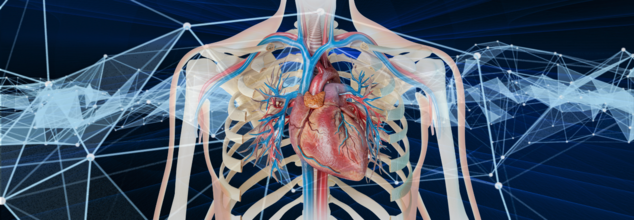- Health Conditions A-Z
- Health & Wellness
- Nutrition
- Fitness
- Health News
- Ayurveda
- Videos
- Medicine A-Z
- Parenting
- Web Stories
Scientists Have Developed An AI Model To Help Predict Sudden Cardiac Risks 'Most Doctors Can't See'

Credits: Canva
Every year, thousands of seemingly healthy people—often young, active, and without obvious warning signs—die suddenly due to cardiac arrest. For decades, doctors have struggled to reliably identify which patients with heart conditions are at high risk and who might be unnecessarily undergoing invasive interventions. That may be about to change.
In a breakthrough that could transform how we predict—and prevent—sudden cardiac death, scientists at Johns Hopkins University have developed an artificial intelligence model that vastly outperforms current clinical standards in identifying people most at risk. Their new system, known as MAARS (Multimodal AI for Arrhythmia Risk Stratification), not only forecasts risk with up to 93% accuracy in vulnerable age groups, but also explains why someone is high risk—something most algorithms fail to do.
The focus of the study is hypertrophic cardiomyopathy (HCM), one of the most common inherited heart conditions. It affects around 1 in 200 to 500 people globally and is a leading cause of sudden cardiac death in athletes and young adults. While most individuals with HCM live normal lives, a subset is at high risk for lethal arrhythmias—heart rhythm disturbances that can cause the heart to stop without warning. And here’s the catch: right now, doctors only have a 50-50 shot at predicting who will be affected.
“Currently we have patients dying in the prime of their life because they aren’t protected,” said Dr. Natalia Trayanova, senior author of the study and a leading figure in AI cardiology research. “And others are putting up with defibrillators for the rest of their lives with no benefit.”
Trayanova is referring to implantable cardioverter defibrillators (ICDs)—tiny devices inserted into the chest that deliver electric shocks to correct abnormal heart rhythms. They save lives in the right patients but come with physical, emotional, and financial burdens when used unnecessarily.
The need for a more precise, personalized tool has never been greater.
What the AI Model Does Differently?
Published in Nature Cardiovascular Research, the new model represents a significant departure from traditional clinical guidelines used across the US and Europe.
MAARS doesn’t rely on a single data source. Instead, it analyzes a multimodal spectrum of information—ranging from electronic health records and patient histories to contrast-enhanced cardiac MRI images that reveal scarring, or fibrosis, within the heart.
Scarring is a key factor in determining sudden death risk in HCM. But interpreting these raw images is extremely challenging for even seasoned cardiologists. That’s where AI has the edge.
“People have not used deep learning on those images,” Trayanova explained. “We are able to extract this hidden information in the images that is not usually accounted for.”
The AI essentially spots dangerous patterns in the heart’s scar tissue that the human eye—and even conventional software—can’t see.
How Accurate Is It?
In clinical tests involving real-world patients from Johns Hopkins Hospital and Sanger Heart & Vascular Institute in North Carolina, the results were staggering:
- Traditional clinical guidelines correctly predicted sudden cardiac death risk only 50% of the time.
- The MAARS model achieved an overall accuracy of 89%.
- In patients aged 40 to 60—a group particularly vulnerable to undetected risk—the model was 93% accurate.
What makes this even more valuable is its ability to provide explanations. The system doesn't just say "this patient is high risk"—it breaks down the why, giving cardiologists critical information to tailor treatment plans.
“This significantly enhances our ability to predict those at highest risk compared to our current algorithms,” said co-author Dr. Jonathan Crispin, a Johns Hopkins cardiologist. “It has the power to transform clinical care.”
Why This Could Be Transformative?
MAARS isn't the first AI model from Trayanova’s lab. In 2022, her team built another tool that provided survival predictions for patients with prior heart attacks, known as infarcts. But this latest model breaks new ground by tackling one of the most elusive forms of cardiac risk—arrhythmias caused by scarring in inherited heart conditions. The potential benefits are wide-ranging:
- Lives saved by identifying at-risk patients who might otherwise be missed.
- Better quality of life for patients who avoid unnecessary ICD implantation.
- More personalized treatment plans based on detailed, AI-generated insight.
Importantly, the model was trained and validated across diverse demographics, showing consistent performance regardless of age, gender, or ethnicity.
The researchers aren’t stopping here. They plan to expand MAARS to include other forms of arrhythmia-related heart diseases, such as cardiac sarcoidosis and arrhythmogenic right ventricular cardiomyopathy—conditions that also carry a high risk of sudden death but suffer from diagnostic ambiguity.
They’re also working to test the model in larger, more varied populations to move it closer to clinical adoption.
A New Era in Cardiology?
Artificial intelligence has long been hyped as the future of medicine. But MAARS is more than hype—it’s a working proof of concept that shows how deep learning can complement medical expertise, not replace it.
AI may soon become your cardiologist’s most powerful diagnostic tool—one that sees what even the best-trained human eyes might miss. And when lives are on the line, that kind of clarity could mean everything.
WHO Releases New Guidelines To Reduce Deaths From Postpartum Hemorrhage

Credits: Canva
On October 5, 2025, leading reproductive health organisations released new guidelines aimed at transforming how postpartum hemorrhage (PPH) is prevented, diagnosed, and treated. The World Health Organization (WHO), along with the International Federation of Gynecology and Obstetrics and the International Confederation of Midwives, released the new guidelines introducing objective criteria to help identify primary postpartum hemorrhage earlier.
WHO Releases New Guidelines For Postpartum Hemorrhage
According to the researchers, even blood loss below the traditional threshold, when accompanied by abnormal vital signs, can indicate a high risk of life-threatening complications. Traditionally, PPH was defined as blood loss of 500 mL or more. The new guidelines suggest that losses of 300 mL or less, when paired with warning signs, should trigger immediate intervention. Early recognition, they note, could save countless lives.
PPH, or excessive bleeding after childbirth, remains a leading cause of maternal deaths worldwide. In 2023, roughly 45,000 out of 260,000 maternal deaths were linked to PPH. While strategies to prevent and manage PPH exist, their application has often been inconsistent. These updated guidelines aim to provide clear, evidence-based guidance that can inform national and local health policies, clinical protocols, and programmatic strategies.
New Guidelines For Postpartum Hemorrhage
The document consolidates 51 recommendations covering prevention, diagnosis, treatment, supportive care, and health system measures. It also emphasises rapid intervention using the E-MOTIVE bundle, which includes:
- Uterine massage
- Oxytocic drugs to stimulate contractions
- Tranexamic acid to control bleeding
- Intravenous fluids
- Examination of the vagina and genital tract
- Escalation of care if bleeding continues
In rare cases where bleeding persists, the guidelines advise measures such as surgery or blood transfusion to stabilize women until further treatment can be provided.
Alongside the guidelines, WHO and partners, including the United Nations Population Fund have developed training and implementation resources. These tools are designed for frontline health workers, offering practical guidance, simulation-based emergency response training, and materials to help implement best practices at national and sub-national levels.
Jeremy Farrar, WHO assistant director-general for health promotion and disease prevention, highlighted the purpose of the new guidance: “These guidelines are designed to maximise impact where maternal deaths are highest and resources are limited, helping more women survive childbirth and safely return home to their families.”
The world is currently off track to meet Sustainable Development Goal 3, which seeks a global maternal mortality ratio below 70 per 100,000 live births by 2030. By improving understanding of PPH causes and advancing timely interventions, health systems can save lives and address deep inequalities in maternal health.
From this year onward, October 5 will be observed as World PPH Day, sending a strong message: no woman should die from preventable postpartum hemorrhage. Concerted global efforts to prevent and treat PPH can play a pivotal role in reducing maternal deaths and improving health equity worldwide.
Skipping Your First Mammogram May Raise Risk of Breast Cancer Death, Study Finds

Credits: Canva
A new study published in The BMJ suggests that women who skip their first mammogram face a higher risk of being diagnosed with advanced breast cancer and dying from the disease. The research, released on September 24, followed over 400,000 women in Sweden for up to 25 years. As October marks Breast Cancer Awareness Month, the findings highlight the importance of early screening.
Skipping the First Mammogram Can Increase Risk
Since the early 1990s, Sweden has offered regular mammography screenings, which have helped reduce breast cancer deaths. Yet, a significant number of women still choose to skip their first appointment. Researchers wanted to understand the long-term impact of missing this initial screening.
The study analyzed data from the Swedish mammography program and national health registries, covering nearly 433,000 women in Stockholm from 1991 to 2020. About 32 percent of women declined their first screening. Those who missed it were also less likely to attend future screenings, often leading to later-stage diagnoses and worse outcomes.
Women who skipped their first mammogram were more likely to be diagnosed with advanced cancer. The risk of developing stage III breast cancer was about 1.5 times higher, and for stage IV, it was 3.6 times higher than among women who attended their first screening.
Over the 25-year follow-up, nearly 1 percent of women who skipped the first mammogram died from breast cancer, compared with 0.7 percent among those who attended—a 40 percent higher mortality risk. Interestingly, the overall rate of breast cancer development was nearly the same in both groups, around 7.7 percent, indicating that the increased deaths were due to delayed detection, not more cases of the disease.
How Mammograms Affect Breast Cancer Risk?
Mammograms use low-dose X-rays to image the breast. While repeated radiation exposure can slightly increase the risk of cancer, the amount of radiation from mammography is minimal. According to the National Cancer Institute (NCI), the risk is most significant when a person undergoes multiple chest X-rays over time.
A 2016 study examined women aged 40 to 74 who received annual or biennial mammograms, noting that repeated exposure could slightly raise cancer risk, particularly for women with larger breasts. However, both that study and more recent reviews conclude that the benefits of regular mammograms far outweigh the risks. Regulatory bodies like the FDA and the Mammography Quality Standards Act ensure that equipment and radiation levels remain within safe limits.
Early detection remains the key: attending the first mammogram can catch breast cancer sooner, improve treatment outcomes, and ultimately save lives.
Lewis Moody, England Rugby Legend, Diagnosed With Motor Neurone Disease: Are Athletes At Higher Risk?

Credits: Lewis Moody Instagram/Canva
Lewis Moody: Former England captain Lewis Moody revealed on Monday that he has been diagnosed with Motor Neurone Disease (MND). Moody, 47, retired from professional rugby in 2012 after a remarkable 16-year career that included stints with Leicester Tigers, Bath, England, and the British and Irish Lions. The flanker lifted nearly every trophy available and played in some of the most high-stakes matches in rugby history. With his diagnosis now public, many are asking: are athletes more prone to developing MND?
What Is Motor Neurone Disease?
Motor Neurone Disease is a group of neurological disorders that progressively destroy motor neurons, the nerve cells responsible for controlling voluntary muscle movements such as walking, speaking, swallowing, and even breathing.
Messages from the brain’s upper motor neurons are transmitted to lower motor neurons in the spinal cord, which then communicate with muscles. When these signals fail, muscles begin to weaken and shrink, a process called muscle atrophy. Damage to lower motor neurons can also cause stiffness and overactive reflexes, making voluntary movements slow and difficult. Over time, MND can result in the loss of mobility and the ability to control other bodily movements.
Currently, there is no cure for MND. The disease is progressive and worsens over time, but certain treatments and interventions can help manage symptoms and improve quality of life.
Lewis Moody, Motor Neurone Disease: Are Athletes at Higher Risk?
Recent research suggests there may be a link between contact sports and MND. A 2022 study from the University of Glasgow, which examined 400 former Scotland rugby players, found they had a higher likelihood of developing the condition. Additionally, researchers at Durham University discovered that rugby players who suffered repeated concussions exhibited biological differences that could make them more susceptible to MND.
The MND Association notes that while there is a correlation between contact sports and MND, it does not necessarily mean that playing sports causes the disease. The studies indicate a greater prevalence among athletes, but they stop short of establishing a direct cause-and-effect relationship.
Symptoms of Motor Neurone Disease
MND often begins subtly, with symptoms appearing gradually. Early warning signs can include:
- Weakness in legs or ankles, causing difficulty climbing stairs or frequent tripping
- Slurred speech (dysarthria)
- Trouble swallowing
- Weak grip, making daily tasks like buttoning a shirt or opening jars challenging
- Muscle twitches and cramps
- Weight loss from shrinking arm and leg muscles
- Involuntary laughter or crying at inappropriate times (pseudobulbar affect)
Causes of Motor Neurone Disease
The exact cause of MND is not fully understood. It is not contagious and generally arises due to a combination of genetic, environmental, and lifestyle factors. Around 10% of cases are inherited, known as familial MND, caused by a genetic mutation. Children of someone with a genetic mutation have a 50% chance of inheriting it, though not everyone with the mutation will develop the disease.Diagnosing Motor Neurone Disease
There is no single test to diagnose MND. Doctors typically rely on symptom observation and physical examinations. To confirm the diagnosis and rule out other conditions, they may use:
- Electromyography (EMG) and nerve conduction tests
- MRI scans of the brain and spinal cord
- Blood tests
- Muscle biopsies
- Lumbar punctures
© 2024 Bennett, Coleman & Company Limited

